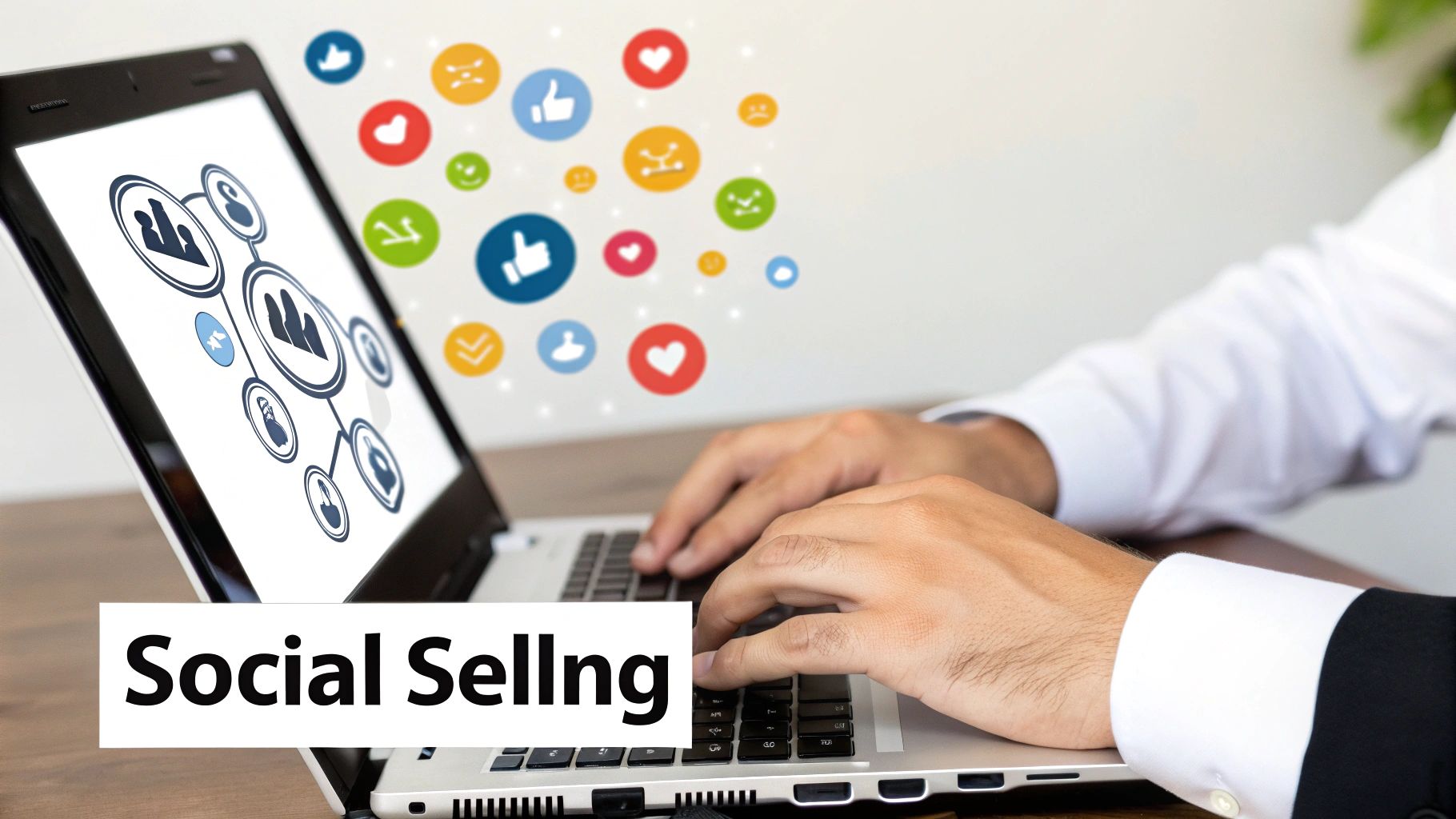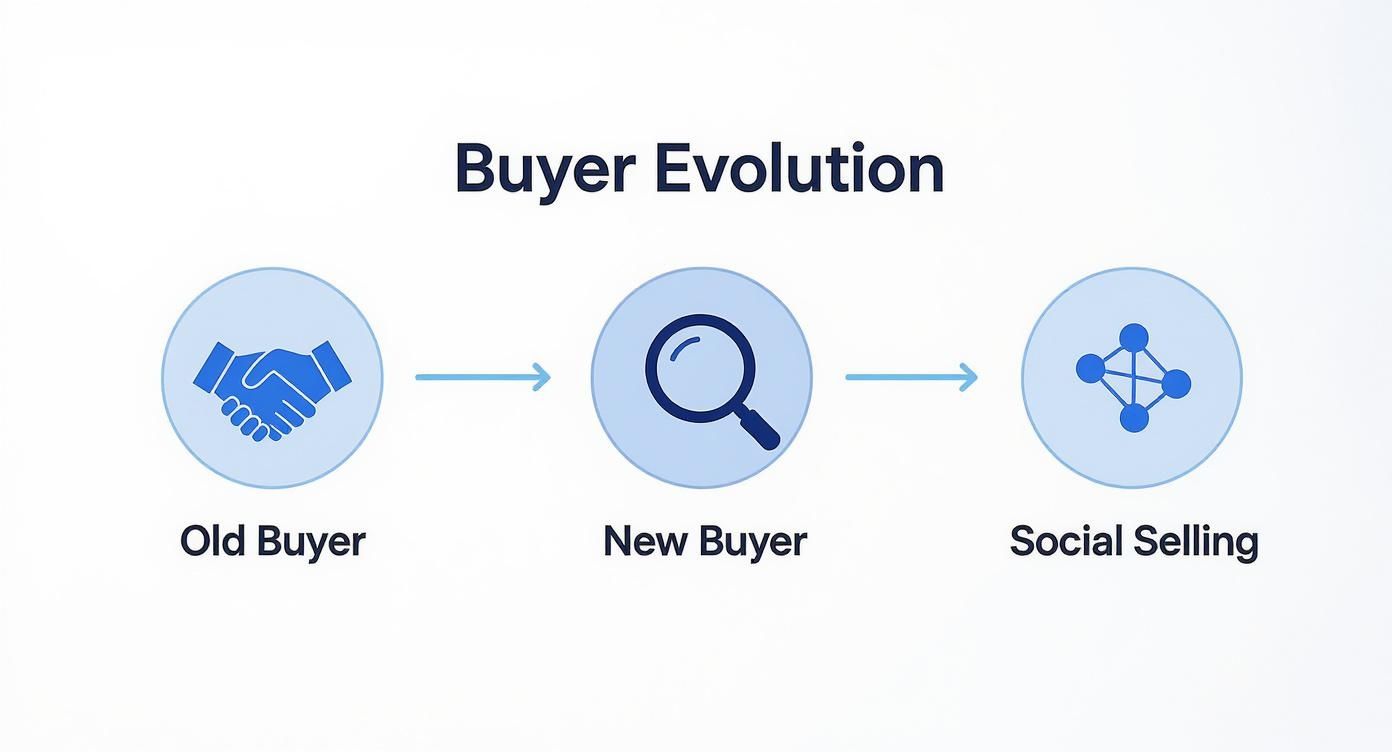What is social selling: A proven guide to boosting revenue
- Janis Kolomenskis
- Oct 22
- 13 min read
Throw out everything you think you know about sales. The days of hammering the phones with cold calls and pushy pitches are over. Welcome to the world of social selling, a much smarter, more human way to build your pipeline.
This isn't just a new buzzword; it's a fundamental shift in how we connect with people. Instead of leading with a sales pitch, you lead with value. You use social media to find the right people, listen to what they're saying, and build genuine relationships long before a transaction is ever on the table. Think of it as moving from a transactional mindset to a relational one.
The New Way to Forge Sales Relationships

Picture a crowded industry conference. The old-school salesperson is the one frantically slapping business cards into people's hands, interrupting conversations with a canned pitch. It's awkward and ineffective.
Now, imagine the social seller. They join a group discussion, listen to the challenges being shared, and offer a genuinely helpful piece of advice. They build rapport and become a familiar, trusted face. That's the essence of social selling, just played out online. It’s about pulling people in by being a valuable resource, not pushing a product on them. You can dive deeper into this relationship-first mindset with these social selling insights from Salesgenie.
Let's take a quick look at how modern social selling fundamentally changes the sales game compared to the old ways.
Social Selling vs Traditional Sales
Aspect | Traditional Selling | Social Selling |
|---|---|---|
Focus | Making the sale, hitting quotas | Building relationships, solving problems |
Approach | Interruptive (cold calls, unsolicited emails) | Non-intrusive (sharing content, engaging) |
Timeline | Short-term transaction | Long-term partnership |
Communication | One-way pitch | Two-way dialogue |
Primary Tool | The telephone | Social media platforms |
As you can see, it's a completely different philosophy. One is about interruption, while the other is about invitation and genuine connection.
From Pitching Products to Building Partnerships
Today's buyers are savvy. They’re armed with more information than ever before. Before they even think about talking to a sales rep, they're already researching solutions, reading reviews, and asking their professional networks for recommendations.
Social selling allows you to meet them right where they are—on platforms like LinkedIn, X (formerly Twitter), and other industry forums. The entire strategy revolves around a few core activities:
Listen First: Tune into conversations about your industry. What are the common pain points? What are people saying about your competitors? This is your goldmine of insight.
Engage Authentically: Don't just lurk. Jump into discussions, share valuable content (yours and others!), and offer helpful advice without asking for anything in return.
Connect with Purpose: Grow your network with relevant contacts. Nurture those relationships over time with genuine, non-salesy interactions.
The real goal isn't just to close a deal; it's to build such a strong reputation that when a prospect finally has a need, you're the first person they think of. You've earned their trust by consistently providing value.
Your Digital Handshake Matters
Your social media profile is your digital first impression. It's your storefront, your resume, and your handshake all rolled into one. A weak, incomplete profile is a massive red flag.
A properly optimized profile clearly shows who you are, who you help, and the value you bring—all in a matter of seconds. For anyone in B2B, a polished LinkedIn profile is non-negotiable. If you want to start with a quick win, check out our guide on [how changing your LinkedIn URL can boost your brand](https://www.yena.ai/post/changing-linkedin-url-how-to-boost-your-brand).
Ultimately, social selling is about playing the long game. It's a move away from aggressive, short-term tactics and toward a sustainable strategy that builds trust, drives revenue, and turns customers into your biggest fans. This isn't just a fleeting trend; it’s the new standard for what it means to be a professional seller.
Why Modern Sales Teams Need Social Selling
Let's be honest, the old sales playbook is broken. Aggressive cold calls and spammy email blasts just don't hit like they used to. In a world where buyers have all the power, these tactics feel invasive and, frankly, a little desperate. This is precisely why cold outreach often falls short today.
Today’s buyers are smart. They’re researchers. Before they even think about talking to a sales rep, they've already hit Google, read a dozen reviews, and asked for recommendations within their own professional circles.
The numbers don't lie. A staggering 75% of B2B buyers now lean on social media to vet vendors and products before they ever make a move. Think about that for a second. The most important part of the buying journey is happening completely without you.
Meeting Buyers on Their Terms
This is exactly where social selling comes in. It’s no longer some trendy, nice-to-have strategy; it's an absolute must. It's your only real way to get into the conversation while your prospects are still in that critical research phase.
Instead of interrupting their day, you meet them where they already are—on platforms like LinkedIn, where they're actively looking for insights and solutions. This is your shot to build real authority and become a familiar, trusted name. A great first step is creating [a winning LinkedIn company page](https://www.yena.ai/post/your-guide-to-a-winning-linkedin-company-page) that acts as a home base for all your valuable content.
When you consistently share helpful advice and join relevant conversations, something powerful happens. You stop being seen as a salesperson and start being viewed as a trusted advisor. You're not just warming up a lead; you're building a genuine relationship based on credibility.
Social selling isn’t about finding new ways to pitch. It’s about building a reputation that makes pitching unnecessary because prospects already see you as the solution.
This simple shift changes everything. When a prospect finally realizes they have a problem you can solve, they don't start from scratch. They immediately think of that expert who's been dropping knowledge bombs in their feed for months.
Shortening the Sales Cycle
The payoff for this trust-first approach is huge, and it hits your bottom line directly. By laying that groundwork of credibility long before the first "sales" conversation, you unlock some serious advantages.
Build a Pre-Qualified Pipeline: Your audience already knows who you are and what you stand for, making them way more open to a chat.
Reduce Friction: You get to skip past that initial wall of skepticism and distrust that kills so many cold outreach attempts.
Dramatically Shorten Sales Cycles: With trust already in place, you can get straight to the heart of the matter and have much more productive conversations.
At the end of the day, social selling lets you build a pipeline of prospects who don't see you as another vendor trying to sell them something. They see you as an essential resource. It perfectly aligns your sales process with how people actually buy things today, making it a non-negotiable strategy for any sales team that wants to win.
The Four Pillars of Social Selling Success
So, what does social selling actually look like day-to-day? It’s not just one thing. It's a full-on framework built on four core pillars. Once you master these, you can turn the whole idea of "building relationships" into a repeatable process that actually drives revenue.
Think of it like building a sturdy table. If you kick out one of the legs, the whole thing gets wobbly and is pretty much useless. The same goes for social selling.
This visual really nails how social selling connects the dots between the old-school, transaction-hungry buyer and today's super-informed, research-obsessed customer.

The big takeaway here? Buyers have all the power now because they have all the information. That means our sales approach has to shift from pushy pitches to building genuine influence first.
Pillar 1: Establish Your Professional Brand
Let’s be real: your social media profile is your digital handshake. It’s often the very first impression a prospect gets, and it has to scream "I know my stuff" in a split second. This isn't just about plastering your job title everywhere—it's about positioning yourself as a credible, go-to resource in your field.
A killer professional brand acts like a magnet. It naturally pulls the right people in by answering two simple questions for them: who do you help, and how do you help them? You do this by tweaking your profile headline, summary, and experience to talk about the results you get for people, not just listing your old job duties.
Pillar 2: Find the Right People
The second pillar is all about smart, strategic prospecting. Forget casting a wide, hope-for-the-best net. Social selling gives you the tools to zero in on the exact decision-makers, influencers, and key players you need to be talking to. We’re moving from random cold outreach to surgical precision.
This means getting really good with the search and listening tools on platforms like LinkedIn. You can filter by industry, company size, and specific roles to create incredibly targeted lists. But it's also about keeping your ear to the ground for buying signals, like a company announcing a big funding round or an executive complaining about a problem you know how to fix. If you want to go deeper on this, check out how to **find people in your network using AI the smart way**.
Pillar 3: Engage with Insights
Okay, you've found the right people. Now what? You engage them with valuable insights, not a sales pitch. This pillar is the absolute heart and soul of social selling. It’s the art of sharing relevant content and jumping into conversations in a way that proves your expertise and builds real rapport.
The golden rule is simple: lead with value, always. Share interesting industry articles, leave thoughtful comments on other people's posts, or even create your own content that solves your audience's biggest headaches.
When you do this consistently, you stay on their radar. So when they finally do have a need, you’re not some random stranger—you’re the trusted expert they've been learning from for weeks.
Pillar 4: Build Strong Relationships
This last pillar ties it all together beautifully. It’s about turning those online connections and casual engagements into genuine relationships built on trust. This is where you smoothly transition the conversation from a public post to a private message, and eventually, to a real call or meeting.
The secret sauce is nurturing these connections over time. A quick, personalized message congratulating someone on a new gig or offering a helpful resource you saw goes an incredibly long way. It's that consistent, authentic follow-up that transforms a passive LinkedIn connection into a warm lead and, ultimately, a fantastic business partnership.
How the Pros Crush It with Social Selling
Alright, enough with the theory. Let's get down to brass tacks and see what social selling actually looks like when it's done right. The top performers aren't just winging it; they have a deliberate game plan to turn online chatter into real business.
Let's break down a couple of real-world scenarios.

Picture Sarah, a B2B tech salesperson who knows her ideal customer—VPs of Operations at mid-sized manufacturing companies—like the back of her hand. Instead of blasting out cold emails that get ignored, she posts a killer case study on LinkedIn. It shows how a similar company boosted its efficiency by a whopping 30% after automating a key workflow.
But she doesn't just post it and pray. She strategically tags a few industry experts (who aren't competitors) to get their thoughts, which instantly sparks a conversation in the comments. This is where the magic happens, and it's a skill the best sellers have perfected. They have a whole playbook of proven strategies for boosting social media engagement to get the conversation rolling.
Turning a Comment into a Conversation
Sure enough, a VP of Operations from one of her target companies chimes in with a thoughtful comment about a similar pain point they're wrestling with. Bingo! That's Sarah's cue. She first replies publicly with another nugget of value, then slides into their DMs with a personalized, no-pressure message.
"Great point on the integration challenges you mentioned. We actually hit that same snag with the company in the case study, and the fix was surprisingly straightforward. Happy to share what we learned if it would help—no sales pitch, I promise."
See what she did there? She completely flipped the tired old sales script. Sarah isn't selling a product; she's offering a solution to a problem the prospect just told her they have. The conversation just flows from there, and before you know it, she’s got a discovery call on the calendar. She turned a simple piece of content into a red-hot lead.
By the way, automating parts of this process can seriously multiply your results. You can learn more about how [AI workflow automation for your business](https://www.yena.ai/post/ai-workflow-automation-for-your-business) can help.
Let's Look at a Financial Advisor
Now, think about Mark, a financial advisor trying to connect with a younger, tech-savvy crowd. He hangs out on X (you know, the platform formerly known as Twitter) to establish himself as a trusted voice. He doesn't just tweet boring market updates; he translates dense financial news into simple, actionable tips people can actually use.
Mark is always listening. He actively looks for people asking questions about investing or retirement and jumps in with clear, helpful answers. His entire strategy is built on being useful.
He hosts weekly Q&A sessions using live audio to tackle questions on the spot.
He creates simple, visual threads that explain confusing topics like Roth IRAs vs. 401(k)s.
He connects with personal finance journalists and bloggers, building a powerful network that amplifies his reach.
Over time, Mark becomes the go-to guy in his niche. His DMs are flooded with messages from people who've followed his advice and now trust him to handle their money. Not a single cold call was made.
Both Sarah and Mark get it. They prove that winning at social selling is all about consistently showing up, adding value, and building genuine trust, one conversation at a time.
Measuring Your Social Selling Impact
So, how do you actually prove that all this time spent on social media is more than just collecting likes and shares? It's time to look past the vanity metrics and zero in on the numbers that really move the needle for your business. The only way to show your strategy is paying off is by tracking the key performance indicators (KPIs) that connect directly to revenue.
A common starting point is LinkedIn's Social Selling Index (SSI), which gives you a handy score out of 100 on how effectively you're using the platform. It’s a great little health check for your professional brand and networking game. Plus, salespeople with higher SSI scores rake in 45% more opportunities than those with lower scores.
Moving Beyond the SSI Score
While the SSI is a great signpost, let's be honest—your sales leader cares about results, not just a score. The real magic of social selling is measured in tangible outcomes that feed the sales pipeline. It's all about drawing a straight line from your daily social activities to closed deals.
To do that, you've got to track specific, business-focused metrics. These are the numbers that bridge the gap between a "like" and a signed contract.
Target Network Growth: Are you connecting with the right people? Track how many relevant decision-makers and influencers you're adding to your network each month.
Qualified Conversations Started: This isn't about spamming DMs. It’s about the number of real, two-way conversations you're sparking with ideal prospects.
Inbound Demo Requests: How many people are raising their hands and asking you for a demo because of your content or engagement? Now we're talking.
The ultimate measure of success is simple: new pipeline and closed-won revenue that you can point to and say, "That came from my work on social." This is how you prove the ROI.
Tying It All to Revenue
Making this connection isn't rocket science, but it does demand discipline. You have to be diligent about tracking the source of every single lead that comes from a social channel. Whether a deal started from a comment thread or a DM after you shared a killer case study, it absolutely must be logged in your CRM.
When you do this, the data tells a powerful story. It turns out that companies that truly get social selling are 51% more likely to hit their sales quotas. By focusing on these core business metrics, you can show everyone that your efforts on social platforms are a critical engine for growth. If you want to dive deeper, check out what the latest social selling statistics reveal.
Got Questions About Social Selling? Let's Dig In.
Jumping into social selling for the first time? It's totally normal to have a bunch of questions. It’s a completely different way of building relationships, so let’s clear up some of the most common sticking points and get you feeling confident right out of the gate.
We're not talking theory here. These are straight-up, practical answers to help you navigate the process like a seasoned pro and dodge those rookie mistakes.
Which Social Media Platform is Actually the Best?
This is the question I hear most often, and the answer is refreshingly simple: Go where your customers are. It’s that easy. While LinkedIn is an absolute beast for B2B, it’s not the only game in town.
Think about it. If you sell a beautiful consumer product, your audience is probably living on Instagram or getting inspired on Pinterest. If you’re in a fast-paced industry like tech or media, the real-time conversations are exploding on X (formerly Twitter).
The golden rule? Do your homework first. Figure out where your ideal customers are actually talking, asking questions, and connecting with their peers. It's so much more powerful to be a known entity on one or two key platforms than to be a ghost on five.
How Much Time Do I Really Need to Spend on This Every Day?
Good news: you don't need to live online to see incredible results. When it comes to social selling, consistency will always crush intensity. A focused, strategic 20-30 minutes a day is more than enough to build serious momentum.
Just block it out on your calendar like it’s a can't-miss meeting. Here’s a simple routine that works wonders:
10 minutes: Share one piece of truly valuable content. Then, spend a few minutes responding to comments on your own posts and in your feed.
10 minutes: Find a handful of new, interesting prospects and send them personalized connection requests. No generic stuff!
5 minutes: Pop into a relevant group discussion or drop a thoughtful comment on a post from an industry leader.
This small daily habit compounds over time, keeping you top-of-mind and filling your pipeline with people who actually want to talk to you.
Is This Really Just for Salespeople?
Not a chance! While salespeople are definitely on the front lines, the core ideas here are a game-changer for anyone whose job relies on building strong professional relationships. Think of it less as a sales tactic and more as a modern professional skill.
Marketers use it to create genuine community buzz and build brand authority. Founders and execs use it to establish themselves as thought leaders and attract amazing talent. Recruiters pretty much live and breathe social selling to connect with fantastic candidates who aren't even looking for a new gig. Even customer success managers use these skills to deepen client relationships and spot opportunities to add more value.
If your job gets better when you have a strong, engaged professional network, then social selling is for you. It’s about building influence and creating opportunities, no matter what your job title says.
What's the Single Biggest Mistake I Should Avoid?
Oh, this one is easy. The absolute worst, most common, and most destructive mistake is connecting with someone and immediately pitching them. It’s the digital version of a slimy cold call, and it instantly kills any chance of building trust. It just screams, "I don't care about you, I only care about what I can get from you."
Social selling is a long game, and it’s built on giving first. Your primary goal, always, should be to lead with value. Share a helpful article, offer a quick insight, introduce them to someone useful, or just give a thoughtful comment on their work.
The sales conversation should feel like the natural next step that flows from a real relationship, one built on credibility and mutual respect. It should never be your opening line. Avoid the premature pitch at all costs, and you’ll already be ahead of 90% of the people out there.
Ready to stop guessing who knows who and start mapping the warmest path to every prospect? Yena transforms your team's scattered contacts into a powerful relationship intelligence engine. Find your next game-changing introduction in 60 seconds.
